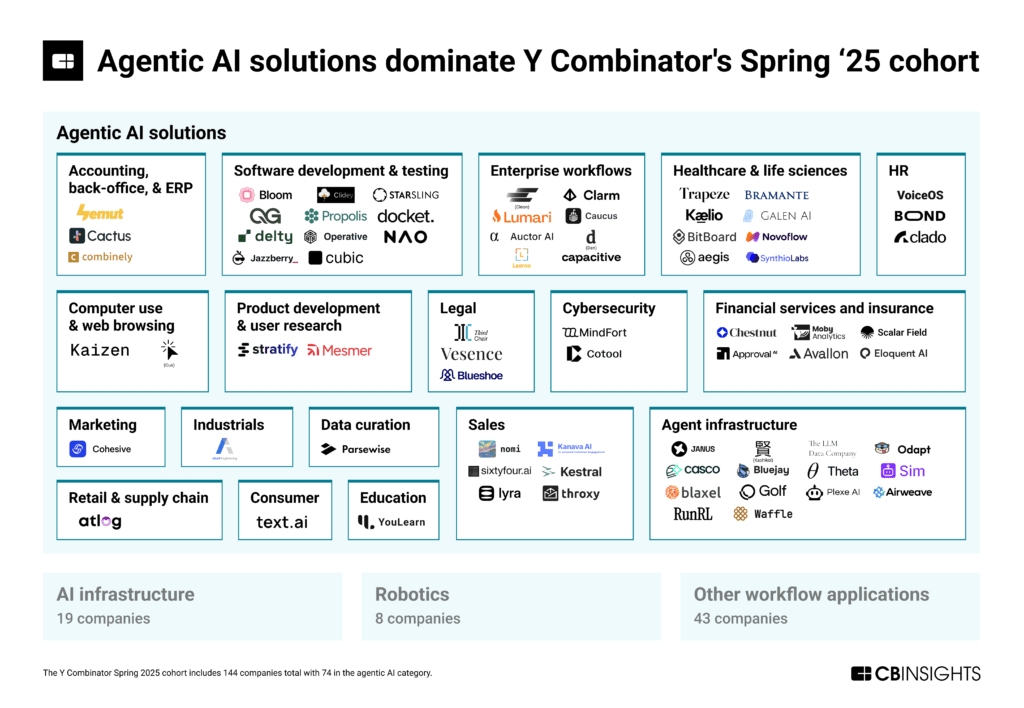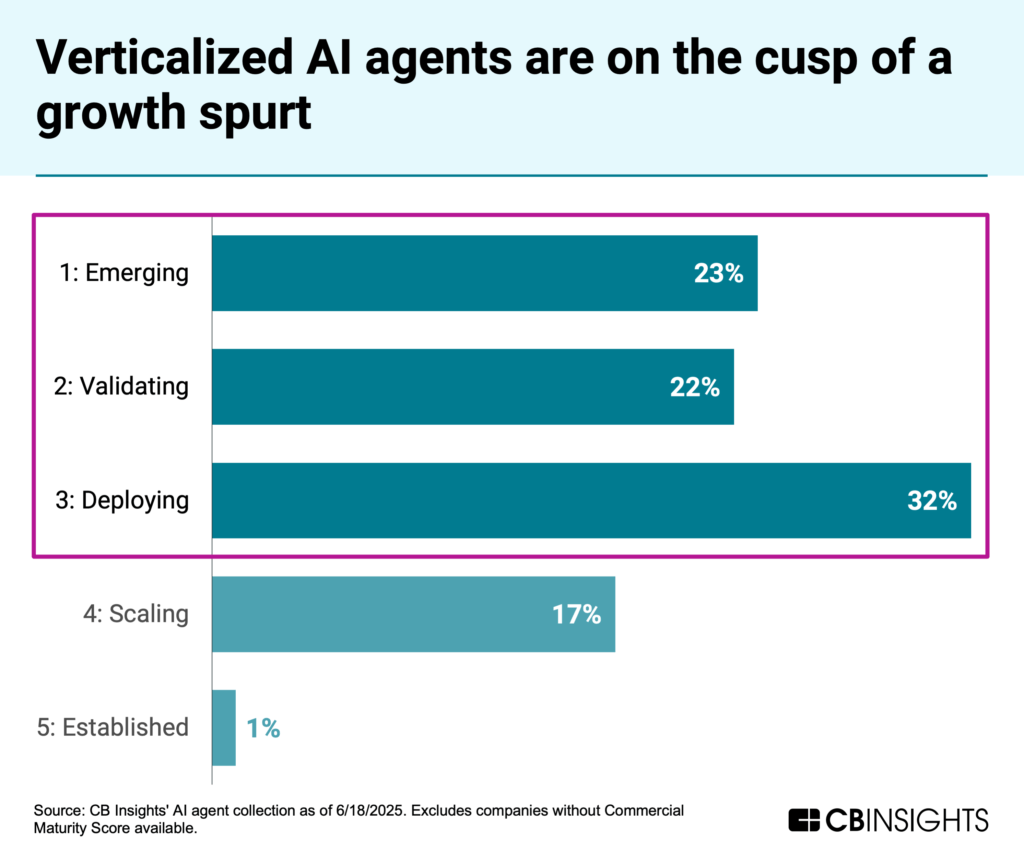We analyze Y Combinator’s Spring 2025 batch to uncover the top trends in agentic AI, spanning workflow automation, software development, and applications in highly regulated industries.
Y Combinator‘s Spring 2025 batch is a preview of agentic AI’s future: over half of the 144 companies are building agentic AI solutions, providing valuable insights for enterprise AI strategies.
The accelerator that spotted OpenAI, Airbnb, and Stripe before they became household names is now placing bets across 4 key agentic AI areas: software development guardrails that de-risk “vibe coding”, web-browsing agents, backend workflow automation, and vertical agents penetrating highly regulated industries.
For strategy teams, this represents both a roadmap of where agentic AI is heading and a curated list of potential acquisition targets, partners, and competitive threats.
Using CB Insights, we mapped the 70+ agentic AI companies in the Y Combinator’s 2025 Spring batch across 18 different categories.
Please click to enlarge.

Note: Categories are not mutually exclusive.
![]() Check out the 140+ startups in Y Combinator’s newest cohort
Check out the 140+ startups in Y Combinator’s newest cohort
Key Takeaways
De-risking AI software development
Software development and testing is the second-largest agentic AI category of this batch, with 11 companies. This reflects the fact that software development AI agents are still booming, with 2025 funding already outpacing 2024 by 3x. Yet this cohort goes beyond coding AI agents, providing engineering support, QA, and guardrails to make vibe coding less risky.
A key focus of these companies is to make vibe coding less risky. For example, over half of the startups in this category focus on testing and review. Operative deploys browser agents that can test coding agents. Docket and Propolis use web agents to QA code and products. Startup Cubic reduces code review bottlenecks, and Jazzberry debugs code, both of which are issues becoming more prominent with the rise of vibe coding.
A handful of companies are developing solutions to support software engineers in vibe coding and automated code generation. Delty is an AI agent that helps with system design and architecture based on deep codebase understanding, and StarSling provides AI agents to augment DevOps.
These new tools will accelerate the growth of more reliable AI software development, boosting existing leaders in the space such as Cursor who could look to acquire them.
Web-browsing agents gather steam beyond general-purpose use
Y Combinator’s dominance in web-browsing agents – backing over 50% of the existing market — signals this emerging category’s potential to become critical infrastructure for agentic AI. LLM giants like OpenAI are already building their own browser agents, but this isn’t deterring startups from entering the space
The Spring 2025 batch reveals how these startups are differentiating themselves by targeting high-value, specific applications rather than building general-purpose agents.
For example, Kaizen provides browser agents that enable outdated, legacy systems to connect with websites without the need for an API. Operative and Propolis are pioneering the use of browsing agents for software testing and quality assurance, areas where automation has historically struggled.
Agents capable of accessing and browsing the web can access more data and information than what is typically available in a company’s systems. This helps provide more context to agentic systems, improving decision-making, and ultimately autonomy.
Agents are coming for the backend
Today, most AI agents focus on frontend interactions and applications, with customer service and enterprise workflow being 2 of the most well-funded AI agent markets. This Y Combinator cohort signals how agents are moving to the backend.
Cactus, Combinely, and Hemut are building back-office systems in areas like accounting and reporting. Caucus and Cohesive developed agent-based CRMs that go beyond the traditional enterprise space to target small businesses and government. Odapt allows custom application development in areas like finance and marketing, built on top of existing tools and systems. Cleon and Auctor AI are automating system implementations.
Currently, these companies focus on narrowly defined, specialized backend workflows. Expanding into more end-to-end workflows will require greater trust in agentic AI applications.
This trust can be partially built through the ability to benchmark AI agent performance. Kashikoi, Janus, and The LLM Data Company – all part of this Spring cohort – are working on this today.
AI agents keep making inroads in highly regulated industries
Once an obstacle for new AI applications, the most highly regulated industries have emerged as targets for agentic AI startups. 32% of verticalized AI agent companies are actively deploying solutions, and 23% and 22% are emerging and validating, respectively, suggesting an oncoming growth spurt.
This impending growth is fully displayed with this batch of Y Combinator companies, particularly in healthcare and financial services, which represent 19% of the agentic AI companies in this year’s Spring cohort.
Customer service and engagement are common areas of focus within these verticals, with companies like Eloquent AI (financial services), Trapeze (healthcare), and Kaelio (healthcare). Other startups are delving deeper into industry-specific workflows, like Chestnut Mortgage and Approval AI (lending and mortgage), and Bitboard (healthcare operations).

We expect the next generation of industry-focused AI agent companies to go beyond operational support and handle research autonomously.
A handful of companies in this batch tackle research assistance today, like Bramante Biologics and SynthioLabs in healthcare and Scalar Field for investment research. These startups lay the foundation for a future in which AI agents can proactively source, digest, and deliver information to human users or automate their roles altogether.
For information on reprint rights or other inquiries, please contact reprints@cbinsights.com.
If you aren’t already a client, sign up for a free trial to learn more about our platform.

